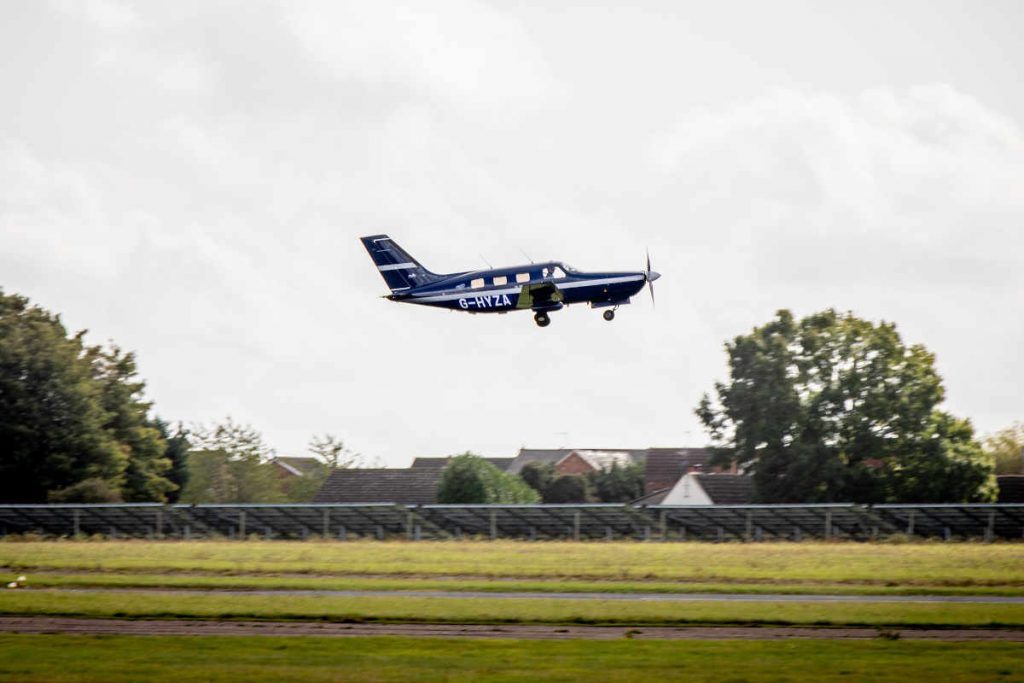
News
Aircraft manufacturers
Electric Propulsion
Fuel
ZeroAvia hydrogen-fuel-cell flight in retrofitted Piper
“While some experimental aircraft have flown using hydrogen fuel cells as a power source, the size of this commercially available aircraft shows that paying passengers could be boarding a truly zero-emission flight very soon.”
September 28, 2020 By Wings Staff
 ZeroAvia’s completes a hydrogen fuel cell powered flight in its commercial-grade retrofitted Piper M-class aircraft. (Photo: ZeroAvia)
ZeroAvia’s completes a hydrogen fuel cell powered flight in its commercial-grade retrofitted Piper M-class aircraft. (Photo: ZeroAvia)
ZeroAvia completed what it describes as the world’s first hydrogen-fuel-cell-powered flight of a commercial-grade aircraft. The flight took place on September 23 at the company’s R&D facility in Cranfield, England, with a six-seat Piper M-class airplane completing taxi, takeoff, a full pattern circuit, and landing.
Based in London, UK, and Hollister, California, ZeroAvia is focused on developing zero-emission aviation with hydrogen and electric technologies. With experimental certificates for its two prototype aircraft, ZeroAvia is initially targeting a 500-mile range with 10- to 20-seat aircraft that can be used for missions like commercial passenger transport, package delivery and agriculture. The company states it is on track to begin commercial operations in 2023.
ZeroAvia explains its September 23 demonstration flight illustrates the possibilities of moving from fossil fuels to zero-emission hydrogen fuels as a primary energy source for commercial aviation. To this end, the company explains hydrogen-powered aircraft could one day match the flight distances and payload of current fossil fuel aircraft. Last week, Airbus introduced three hydrogen-powered commercial aircraft concepts with a goal of entering one into service by 2035.
Airbus outlines three potential zero-emission aircraft
This new ZeroAvia milestone is part of the HyFlyer project, described by the company as a sequential R&D program supported by the UK Government. It follows what ZeroAvia describes as the UK’s first ever commercial-scale battery-electric flight, conducted in the same aircraft in June.
First flight for Harbour Air all-electric aircraft
ZeroAvia explains it will now turn its attention to the next and final stage of its six-seat development program, which centres around operating a 250-mile, zero-emission flight out of an airfield in Orkney before the end of the year. The demonstration of this range, according to ZeroAvia, is roughly equivalent to busy major routes such as Los Angeles to San Francisco or London to Edinburgh.
“It’s hard to put into words what this means to our team, but also for everybody interested in zero-emission flight,” said Val Miftakhov, CEO, ZeroAvia. “While some experimental aircraft have flown using hydrogen fuel cells as a power source, the size of this commercially available aircraft shows that paying passengers could be boarding a truly zero-emission flight very soon.”
ZeroAvia’s program in the UK is partly funded through the UK Government’s Aerospace Technology Institute (ATI) program called HyFlyer, in which ZeroAvia is working with partners, including the European Marine Energy Centre (EMEC) and Intelligent Energy, to de-carbonize medium-range small passenger aircraft by demonstrating powertrain technology to replace conventional engines in propeller aircraft.
Intelligent Energy will optimize its high-power fuel cell technology for application in aviation, explains ZeroAvia, while EMEC will supply the hydrogen required for flight tests and develop a mobile refuelling platform compatible with the aircraft.
“Developing aircraft that create less pollution will help the UK make significant headway in achieving net zero carbon emissions by 2050,” said Nadhim Zahawi, Business and Industry Minister, UK. “Backed by Government funding, this flight is another exciting milestone in ZeroAvia’s project. It shows that technologies to clean up air travel are now at our fingertips – with enormous potential to build back better and drive clean economic growth in the UK.”
In addition to the aircraft work outlined above, ZeroAvia and EMEC have developed the Hydrogen Airport Refuelling Ecosystem (HARE) at Cranfield Airport. ZeroAvia describes this as a microcosm of what the hydrogen airport ecosystem will look like in terms of green hydrogen production, storage, refuelling and fuel cell powered-flight. The company states this infrastructure effort also marks another world’s first as a fully operational hydrogen production and refueling airport facility for primary commercial aircraft propulsion.
“This is an important milestone for HyFlyer and UK aerospace, and we send our congratulations to the team,” said Gary Elliott, CEO of the Aerospace Technology Institute. “It is through supporting projects such as HyFlyer, and new and innovative companies such as ZeroAvia, that the ATI aims to deliver our vision for future sustainable aviation and secure a lead for UK aerospace in the highly-competitive global market.”